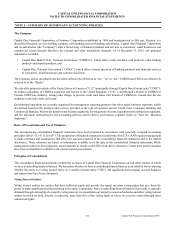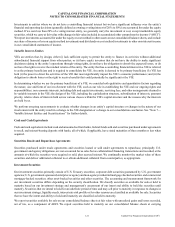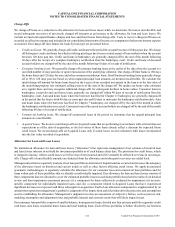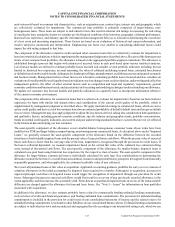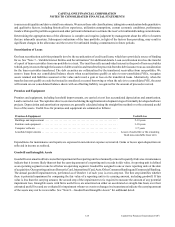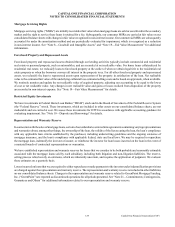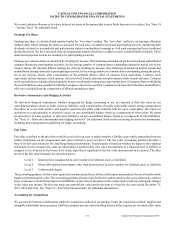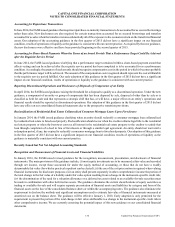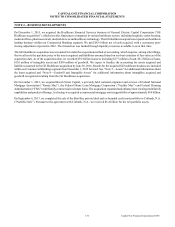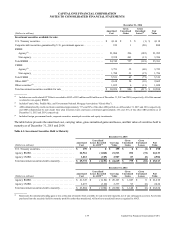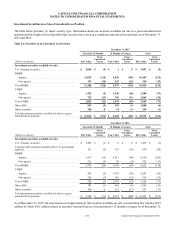Capital One 2015 Annual Report Download - page 149
Download and view the complete annual report
Please find page 149 of the 2015 Capital One annual report below. You can navigate through the pages in the report by either clicking on the pages listed below, or by using the keyword search tool below to find specific information within the annual report.CAPITAL ONE FINANCIAL CORPORATION
NOTES TO CONSOLIDATED FINANCIAL STATEMENTS
130 Capital One Financial Corporation (COF)
Customer Rewards Reserve
We offer products, primarily credit cards, which include programs that allow members to earn rewards, in the form of points, that
can be redeemed for cash (primarily in the form of statement credits), gift cards, airline tickets or merchandise, based on account
activity. The amount of reward that a customer earns varies based on the terms and conditions of the rewards program and product.
Customer rewards costs are generally recorded as an offset to interchange income, with a corresponding increase to the customer
rewards reserve, when the rewards are earned by the customer. The customer rewards reserve is computed based on the estimated
future cost of earned points that are expected to be redeemed and the average cost per point redeemed. The customer rewards
reserve is reduced as points are redeemed. In estimating the customer rewards reserve, we consider historical rewards redemption
behavior, the terms and conditions of the current rewards programs and card purchase activity. The customer rewards reserve is
sensitive to changes in the reward redemption type and redemption rate, which is based on the expectation that the vast majority
of all points earned will eventually be redeemed. The customer rewards reserve, which is included in other liabilities on our
consolidated balance sheets, totaled $3.2 billion and $2.7 billion as of December 31, 2015 and 2014, respectively.
Revenue Recognition
Interest Income and Fees
We recognize interest income, including finance charges, and fees on loans in interest and non-interest income in our consolidated
statements of income in accordance with the contractual provisions of the credit arrangements. Loan origination fees and costs
and premiums and discounts are generally deferred and amortized over the average life of the related loans using the effective
interest method, except for those related to credit cards, which are amortized over 12 months on a straight-line basis. Direct loan
origination costs consist of both internal and external costs associated with the origination of a loan.
Finance charges and fees on credit card loans, net of amounts that we consider uncollectible, are included in loan receivables and
revenue when the fees are earned. Annual membership fees are deferred and amortized into income over one year on a straight-
line basis. We continue to accrue finance charges and fees on credit card loans until the account is charged-off. Our methodology
for estimating the uncollectible portion of billed finance charges and fees is consistent with the methodology we use to estimate
the allowance for incurred principal losses on our credit card loan receivables.
Interchange Income
Interchange income represents merchant fees for credit card transactions processed through the MasterCard® (“MasterCard”) and
Visa® (“Visa”) interchange networks, net of the fee retained by the merchant’s processing bank. The levels and structure of
interchange rates are set by MasterCard and Visa and are based on cardholder purchase volumes. We recognize interchange income
as earned at the time of purchase.
Card Partnership Agreements
Our partnership agreements relate to alliances with retailers and other partners to provide lending and other services to mutual
customers. We primarily issue private-label and co-branded credit card loans to these customers over the term of the partnership
agreements, which typically range from two to ten years.
Certain partners assist in or perform marketing activities on our behalf and promote our products and services to their customers.
As compensation for providing these services, we often pay royalties, bounties, or other special bonuses to these partners. Depending
upon the nature of the payments, they are recorded as a reduction of revenue, marketing expenses or other operating expenses. We
have certain credit card partnership arrangements in which our partner agrees to share in a portion of the credit losses associated
with the partnership.
If a partnership agreement provides for profit, revenue or loss sharing payments, we must determine whether to report those
payments on a gross or net basis in our consolidated financial statements. We evaluate the contractual provisions of each transaction
and applicable accounting guidance to determine the manner in which to report the impact of sharing arrangements in our
consolidated financial statements. Our consolidated net income is the same regardless of whether revenue and loss sharing
arrangements are reported on a gross or net basis.


